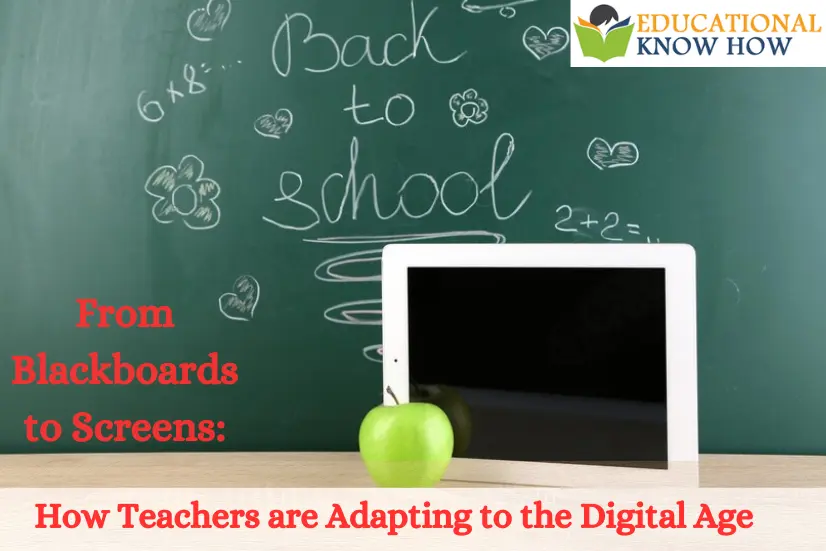
In today’s fast-paced and ever-changing world, the influence of technology has extended to virtually every aspect of our lives, including the realm of education. With the advent of modern technology, digital tools and resources have become integral to the educational landscape, transforming how teachers teach and students learn.
EVOLUTION OF EDUCATION
1. Traditional Methods of Teaching
For centuries, blackboards and chalk were the primary tools used by teachers to convey information to students. Teachers would write on the blackboard, and students would copy the notes onto their notebooks. While this method was effective back then, it had its limitations. It was time-consuming, required a lot of effort, and limited the pace of learning. Moreover, it heavily relied on memorization rather than fostering creativity and critical thinking skills.
2. Transition from Blackboards to Screens
Over the past few years, there has been a clear shift from traditional blackboards to classroom screens in educational settings across the globe. Digital whiteboards, smart boards, and other digital tools have replaced traditional blackboards, offering a more dynamic and interactive learning experience. Teachers can now create visually appealing presentations, incorporate multimedia elements, and use educational institutes update and software to enrich their lessons. This shift has made the teaching process more efficient and empowered students to be active participants in their learning journey, fostering a more interactive and engaging educational experience.
CHALLENGES AND OPPORTUNITIES
While technology has brought about numerous educational opportunities, it has also posed challenges for teachers navigating the digital age.
1. Perplexity and Burstiness in the Digital Age
The constantly evolving nature of technology poses one of the challenges that teachers often encounter. Digital tools and resources are continually changing, and it can be overwhelming for teachers to keep up with the latest learning trends and innovations. The rapidly changing landscape of the digital age presents teachers with perplexity as they need to adapt quickly to new technologies, platforms, and apps.
2. Specificity and Context in Digital Teaching
Another challenge is maintaining specificity and context in the digital teaching environment. With the abundance of online information, it can be challenging for teachers to curate relevant and accurate content that meets the specific needs of their students and the education industry trends. Teachers must ensure that their digital resources are reliable, accurate, and aligned with the curriculum and learning objectives. Contextualizing the digital content and making it relevant to the student’s lives is also essential for effective digital teaching.
TEACHERS’ ADAPTATION
Teachers are taking proactive steps to adapt to the digital age and leverage technology to create meaningful learning experiences for their students.
1. Professional Development for Digital Literacy
Many teachers recognize the importance of developing digital literacy skills to integrate technology effectively into their teaching. Teachers actively engage in professional development programs, attend workshops, and seek out training opportunities to continuously improve their technical skills and stay abreast of the latest trends in education. Digital literacy has become an essential competency for teachers in the digital age, enabling them to navigate and utilize technology effectively in their classrooms.
2. Utilizing Technology for Engaging Learning
Teachers incorporate digital tools and resources to make their lessons more engaging and interactive. From online educational platforms and learning management systems to educational apps and gamified learning experiences, teachers are leveraging technology to create dynamic and personalized learning opportunities for their students. Interactive multimedia presentations, virtual field trips, and collaborative online projects are ways teachers utilize technology to enrich the learning experience and foster student engagement.
3. Balancing Technology and Traditional Methods
While technology has become integral to modern education, teachers understand the importance of balancing technology and traditional teaching methods. They recognize that technology is a tool, not a substitute for effective teaching practices. Teachers carefully select the right digital resources that align with their curriculum and pedagogical approach. They also ensure that students have ample opportunities for hands-on, experiential, and collaborative learning beyond screens. The aim is to create a blended learning environment combining the best digital and traditional teaching methods.
As the world rapidly evolves into the digital age, teachers adapt to the changing education landscape. While challenges such as perplexity and burstiness exist, teachers are actively developing their digital literacy skills and finding innovative ways to incorporate technology in their classrooms. By balancing technology and traditional methods, teachers prepare students for the digital age while ensuring a holistic and effective learning experience.
At Educational Know-How, we actively strive to offer top-notch educational solutions that harness the power of technology in education. Count on Educational Know How to be your trusted ally in this exciting journey.
